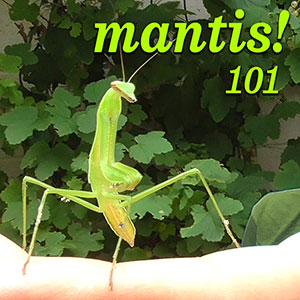How to Grow, Harvest, Eat & Control: Maypop (Cold-Hardy Passionfruit Vine) Passiflora Incarnata!
The passionflower is one of the most stunning, exotic looking flowers. Their resulting passion fruits have an amazing aroma and sweet tropical flavor. I first planted mine seven years ago. And since that time they've really taken off!
This is a complete page covering quick and tips helping you to ensure success with growing maypops! I'm getting loads of passion fruits! There's some important info that you really need to know if you're considering growing passion fruit vines. You really need to know this before deciding to plant a passion fruit vine...
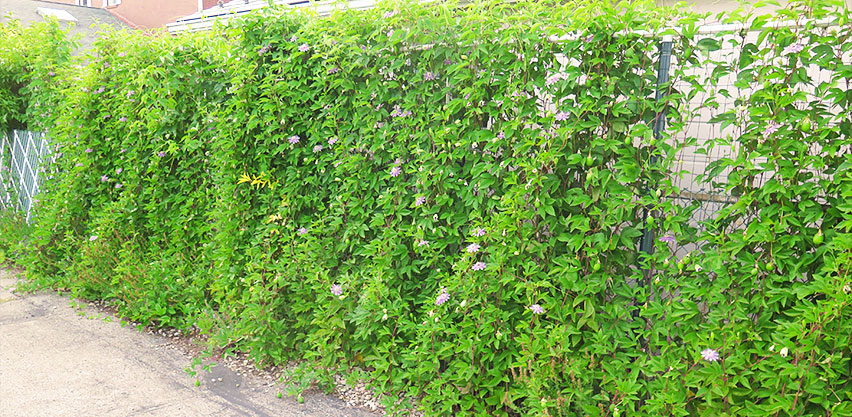
7 years after planting this vine, it has grown massively with beautiful flowers and lots of fruit production!
- Quick Facts About: Maypop, Passiflora incarnata
- Maypop Passiflora incarnata: Overview
- Common names for Passiflora incarnata.
- How to Grow Passionfruit Vines:
- Can you grow passion fruits in temperate climates?
- How to grow passion fruits in cold climates?
- How to propagate passion fruit vines?
- Why isn't maypop vine coming up in the spring?
- Why passionfruit vine doesn't makes flowers?
- Tips for Good Passion Fruit Harvests:
- Why passionfruit make flowers but no fruit?
- How to tell when maypop passionfruits are ripe?
- How large do maypop passion fruits get?
- How to eat Passiflora incarnata fruits?
- What do Maypop passionfruits taste like?
- Problems with Growing Passionfruit Vines:
- Is the Maypop passionflower highly / extremely flammable?
- Is the Passiflora incarnata passionflower a native plant?
- Is the Maypop Passiflora incarnata an invasive plant?
- How to control the passionfruit plant?
Video: How to Grow, Harvest, Eat & Control:
Maypop (Hardy Passionfruit Vine)
-Passiflora Incarnata -QUICK TIPS!
Growing cold-hardy maypop passion fruit vines can be a very rewarding, tasty experience!
Quick Facts About:
Maypop, Passiflora incarnata
Maypop Passiflora incarnata: Overview
- QUICK FACTS:
- Family: Passifloraceae
- Genus: Passiflora
- Botanical name: Passiflora incarnata
- USDA Cold Hardiness Zones: Zone 5-10
- AHS Heat Zones: 12-4
- Light Requirements: Full Sun, Part Sun
- Type: Herbaceous Perennial, Vine
- Growth Habit: Indeterminate
- Height: 6–8 feet
- Bloom Time: Early Summer – Late Fall
- Ripening Time: 8+ weeks after flowering
- Pollination Requirement: May need cross-pollination, possibly self-compatible
- Fruit Size: Up to 2" x 2.625" / 45 g

Regardless of what you call it, the maypop passionflower is a truly remarkable flower!
Common names for Passiflora incarnata:
There is a rather extensive list of common names which have been applied to Passiflora incarnata. These include: Apricot, Apricot vine, Field apricot, Chassepareille blanche, Ground ivy, Holy Trinity flower, Liane de grenade, Mayapple, Maypop, Mollie cockle, Molly-pop and Pop-apple (McGuire, 1999, p. 163). Different names are commonly used in different geographic areas within the US. Additionally, the plant has been referred to as Passionflower, Passion Flower, Purple Passionflower, Passion Vine and Wild Passionfruit. Out of all of these, maypop is probably one of the most common and distinctive designations for the Passiflora incarnata.

This cold-hardy passionfruit vine is perfect for edible landscaping in temperate climates!
How to Grow Passionfruit Vines:
Can you grow passion fruits in temperate climates?
Yes! Many passionfruit vines are tropical and can only grow in zone 9 or warmer. But the Passiflora incarnata is a cold hardy passionfruit. It has been known to grow as cold as USDA zone 5. Maypops have been grown as far north as New York, Massachusetts and Cleveland, Ohio. Ideally, the plants need an average frost-free period of 150 days.

This lovely Passiflora incarnata vine makes for a nice privacy screen in my temperate zone 6 climate.
How to grow passion fruits in cold climates?
Step 1: Select Passiflora incarnata! This cold-hardy passiflora has the best chance of surviving cold winter freezes. If the weather is exceptionally cold, the plant might not make it through the winter. This was observed to be the case many years ago in areas like northern Illinois or central New York. But as climate change leads to increasingly warm temperatures, growers may find success in areas that were previously too cold.
PROTECT THE ROOTS:To survive the cold of winter, the plant's roots and shoot buds need to be deep in the part of the soil that doesn't completely freeze. So you can factor this in when selecting a planting location. Plant the vine in the warmest, south-facing spot on your lot. If your property has any warm micro-climate pockets, all the better! The foliage will completely die down when the weather begins to freeze. But you can protect the roots with a nice layer of mulch.
How to propagate passion fruit vines?
It's not hard to order a maypop Passiflora incarnata vine online if you'd like to grow one. But if you know someone who has a passionfruit plant, they can easily propagate it for you for free! There are two simple ways to cultivate your own plants. Passiflora incarnata can be reproduced either sexually or asexually. Each method works well, but they have their own advantages and disadvantages.
GROWING PASSION FRUITS FROM SEED: If someone gives you a maypop fruit, you can save the seeds and then plant them to grow your own vine. This is considered sexually reproduction. It offers a couple key benefits. By growing passion fruit vines from seed, you can ensure that they do not have any diseases like viruses. There's also the possibility that the new plants will have some interesting traits that make them even more desirable than the parent plant. This is a double-edge sword though. When grown from seed, there is a measurable of variability. It's possible that the resulting plants won't have as many desirable traits as the original. Also, the seed-grown plants will take a little longer to become established.
It's best to cold stratify Passiflora incarnata seeds for 6 months if you want optimal germination rates. To do this, you can store them in a refrigerator between 32° to 40° F. Then you can soak them for 24 hours before planting them. Do not scratch them up (scarify) or treat them with acid. It's possible to get flowers in the very first year that you plant the seeds.
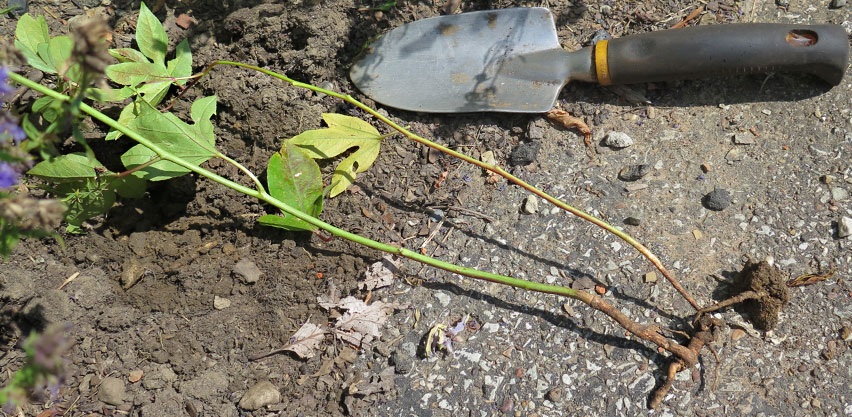
It was very easy to dig up a root segment which allowed me to propagate this passiflora vine.
CLONING PASSION FRUITS: There are two basic ways to propagate passion fruit vines asexually. It's possible to take stem cuttings. But I find it much easier to simply dig up a piece of the root or rhizome. I'll look for suckers that are growing in a location where I don't really want them to. Rather than simply yanking out the sucker, I gently dig around the base to expose the root segment that it's attached to. Make sure you get a piece that is at least 2 or 3 inches. Then snip off the top part of the stem shoot, leaving only the bottom two leaves. Be sure to prevent it from drying out. Quickly pot up the plant and water it well.
This technique can be done during the middle of the summer. This can give you a good head start on the next growing season. Plants grown this way will be able to grow faster than ones grown from seed, since the root fragment has more energy than a single seed. This is a good way to ensure that the plant you grow is an exact clone of the original. It will have all of the traits that made the parent plant so great. The main drawback is that if the original plant was infected with a virus or other disease, then this will be transmitted to the new plant.
Why isn't maypop vine coming up in the spring?
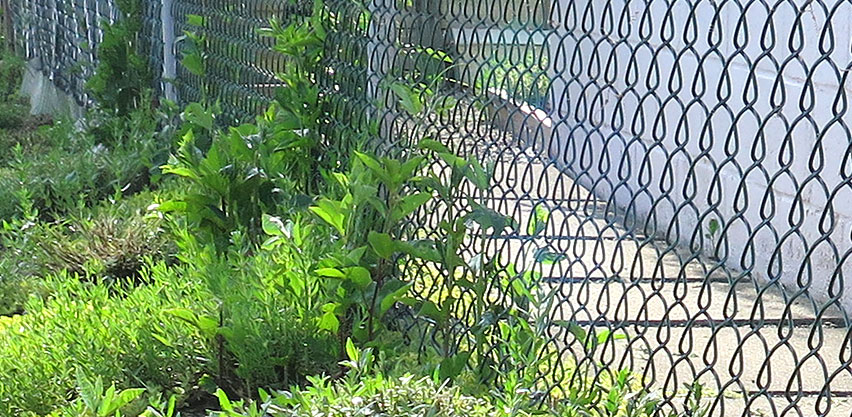
Although it's late May, this passion fruit vine is only beginning to grow for the new season.
It may simply take time. Maypop passion vines are cold hardy, but they are still heat loving plants. It takes time for the soil to warm up in the spring. As the soil heats up, you should expect to see vine emerging in mid to late spring. In zone 6, my passion vines don't wake up until May.
Why passionfruit vine doesn't make flowers?
The Passiflora incarnata vine is capable of producing flowers within the very first year that it emerges as a seedling. It should then continue to flower each season in the following years. Because maypops have an indeterminate growth pattern, they will continue to produce flowers throughout the growing season until the vine is damaged by cold weather. If the vine grows exceptionally tall, you may find that much of the new flowers occur at the upper part of the plant where the newer growth is.
However, you should still expect to be seeing new flowers on a fairly regular basis, as long as the weather is warm enough. If you see adequate growth of healthy green foliage, but fail to see any blooms, it might be due to poor sun exposure. For optimal flowering, passifloras should be planted in full sunlight. In the northern hemisphere, that means they should be planted in a spot where they get southern exposure.
Tips for Good Passion Fruit Harvests:
Why passionfruit makes flowers but no fruit?
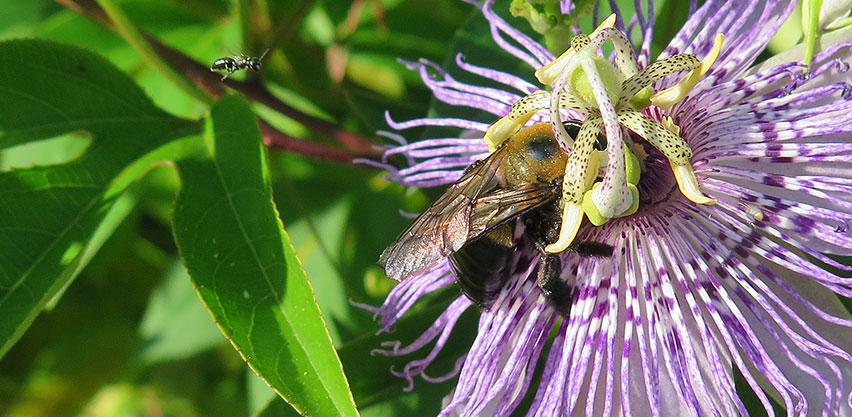
Carpenter bees are extremely effective pollinators for passifloras, resulting in excellent fruit set!
Poor pollination. Passionfruits can be pollinated by hand with a cotton swab. It's easier to attract pollinators. Grow plenty of flowering herbs. Avoid insecticides. Do not trap and kill bumblebees or carpenter bees. Carpenter bees are the ideal pollinator for Passionfruits.
How to tell when maypop passionfruits are ripe?

Unlike many other passion fruits, the Passiflora incarnata makes green fruits.
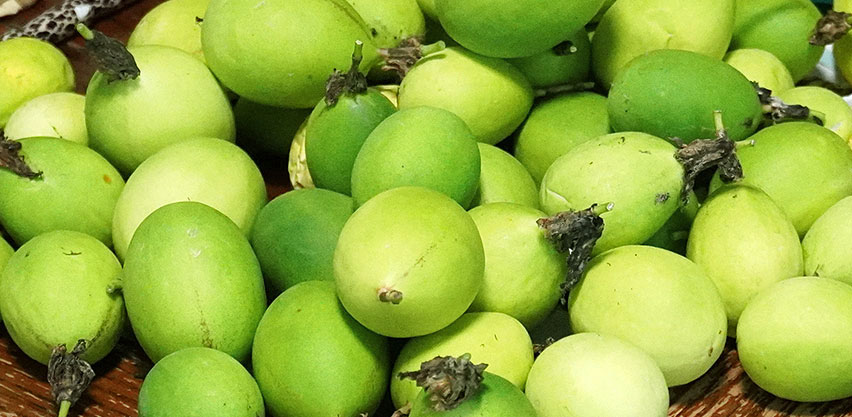
These passion fruits have turned more of a pale, yellow green indicating they are ripe and sweet!
Passiflora incarnata fruits are green, even when ripe. But you can tell that they are ripened because they change from a deep emerald green to a pale yellow-green in color. The skin on an immature fruit feels a little more firm and rigid. But ripe ones get a little more delicate and softer to the touch When the fruits are completely ripe, they will drop off of the vine. You can simply pick them up to harvest! If you see any that have begun to shrivel, I suggest eating them right away. If you wait too long they may get overripe.
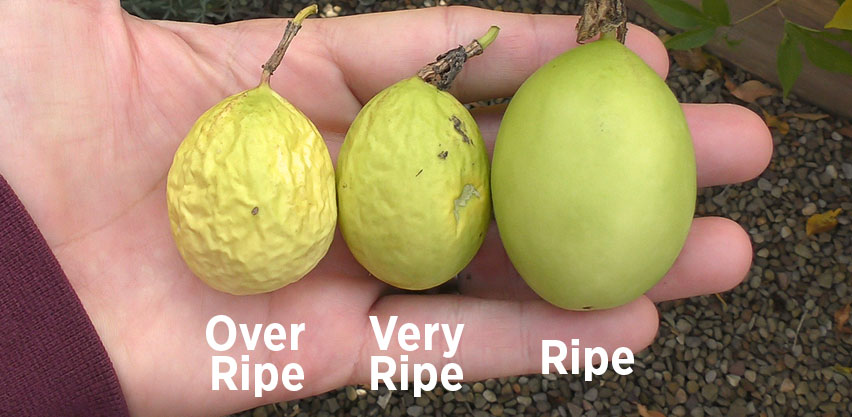
I try to eat the maypop passion fruits before the skins get excessively wrinkled.
How large do maypop passion fruits get?
There is a significant variability in the size of fruits from maypop Passiflora incarnata. Some fruits may be extremely small, perhaps only 1" x 1.25" in size. However, the very same plant can produce rather large passion fruits. I've personally measured one that was 2 x 2.625 inches! It weighed a whopping 45 grams. Much of the size differential depends on how well the flower had been pollinated. However, it's possible to compare 2 fruits that are exactly the same size. Yet, one fruit might weigh quite a bit more. It may be full of pulp while the other one has a very large air pocket.
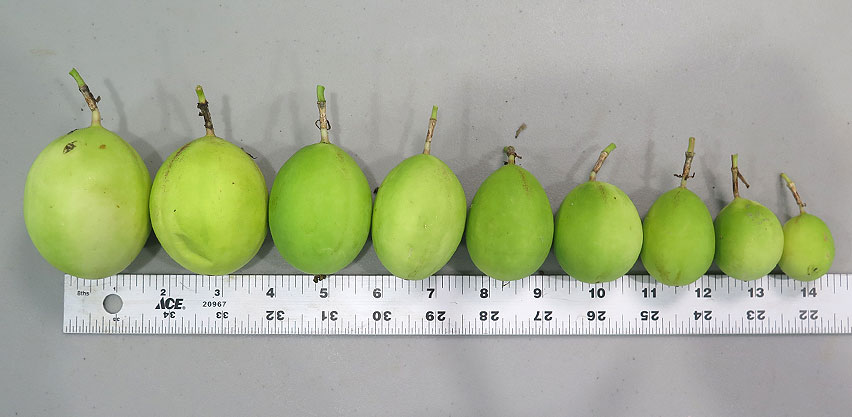
Not all of them are large, but I've gotten some massive passion fruits from my maypop vine!
How to eat Passiflora incarnata fruits?
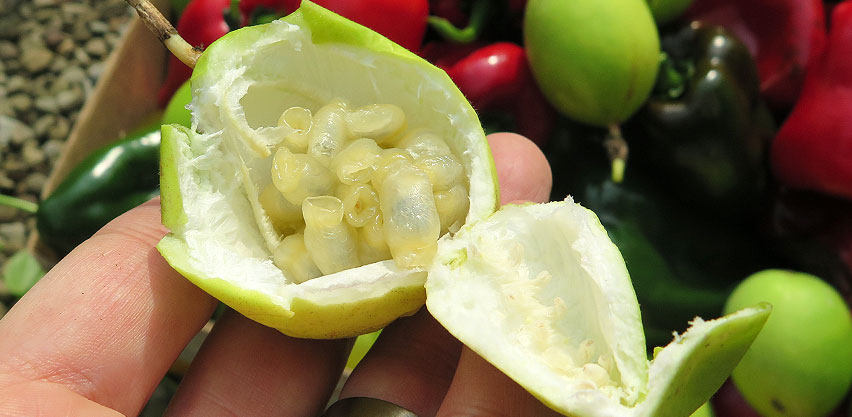
The skin of the fruit is east to tear open, revealing the soft, juicy fruit pulp with a slight amber color.
To eat the passion fruits, you simply pinch the soft outer skin and tear them open. Then you can scoop out the soft pulp. If there is a bit of white membrane surrounding the pulp you can just pull it away. Try swooshing the pulp around in your mouth and just swallow it whole, with seeds intact. The seeds are large and very hard. Technically, you could bite down on them, making a very loud crunch. But I prefer not to bite into the seeds, because I would rather not break a tooth!
What do Maypop passionfruits taste like?
The fruits are very aromatic. They have a sweet tropical smell. The pulp is squishy and juicy. I agree with Lee Riech who claims that it tastes like Hawaiian punch! I've also been told that maypop passion fruits taste like "a cross between a banana and kiwi." Or even "like jello candy." Regardless of your impression, most people agree that the fruit is delicious and it is easy to eat out of hand.

The sweet tropical tasting passion fruit pulp is juicy and delicious!
Problems with Growing Passionfruit Vines:
Is the Maypop passionflower highly / extremely flammable?
Some sources claim the passionfruit vine is a serious fire hazard. Despite my best efforts, I've seen NO studies that actually demonstrate this. I cannot find any published literature establishing that passifloras are "extremely" flammable. Any sites that make reference of this, are completely devoid of credible references to back up that claim.
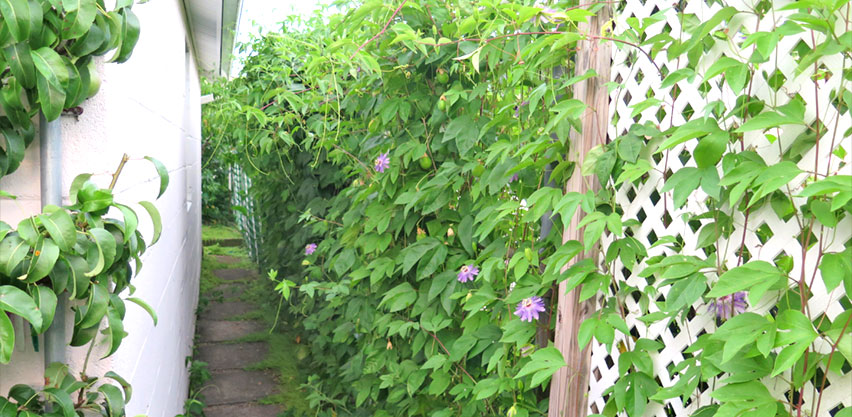
Any vining plant can look beautiful next to your home, but fire risk must be considered, especially in wildfire prone areas.
WILDFIRE RISKS OF VEGETATION: It's important to understand that most vegetation has the potential to become flammable. This especially applies to dead vegetation. However, even living plants can become fuel sources for fires if they are allowed to dry out during times of drought. A plant may be well watered, but it can dry out quite quickly when subjected to the extremely high temperatures associated with wildfires. Once the foliage has become desiccated, it can be ignited much more easily. But this applies to nearly all plantings, not just ones that are classified as "flammable."
Some plants are even more flammable than others though. This is often due to various volatile oils, waxes or resins contained within the plant tissues. Plants may produce gummy sap which can ignite quite quickly. In contrast, there are a few plants such as redwoods which tend to be quite fire resistant due to the composition of their bark. So there is a bit of a range from the lesser to the more flammable plants.
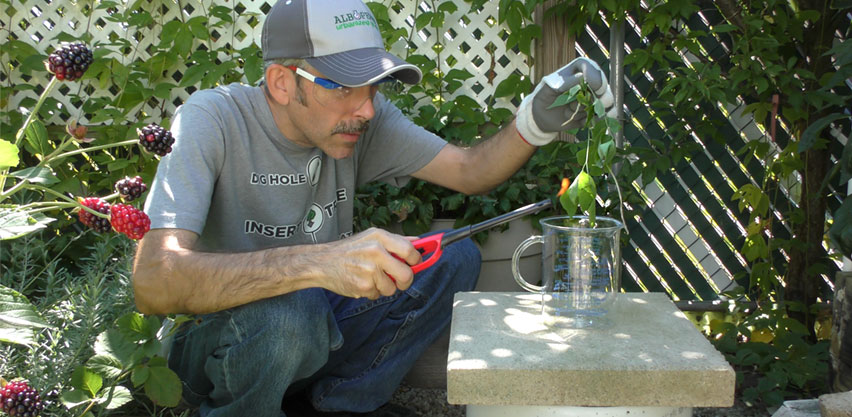
Proper lab tests use strict protocols, but I did not find this vine to have extra flammability vs other fresh plants & herbs.
Where does the Passiflora incarnata fit it? In my anecdotal testing, I found that the fresh green leaves and vines are not quick to ignite. Perhaps the foliage needs to be dried and dessicated before becoming highly flammable? I'm not aware of any specific compounds in the maypop which make it an "extreme" fire risk. Certainly, it's not going to spontaneously combust on the first hot summer day.
Cultivation practices can help out quite a bit. By removing old, dead growth, you can help to mitigate fire risk associated with ALL of the plantings on your property. Some sites will warn against growing passionfruit vines on an arbor next to your home. Simply switching to a different vine won't magically protect your home from wildfires. Whether they are "highly flammable" or not, any plant materials could become a fire bridge, leading flames right up to your home. If you have wildfire concerns, do not plant ANY plant materials next to your structures.
Is the Passiflora incarnata passionflower a native plant?
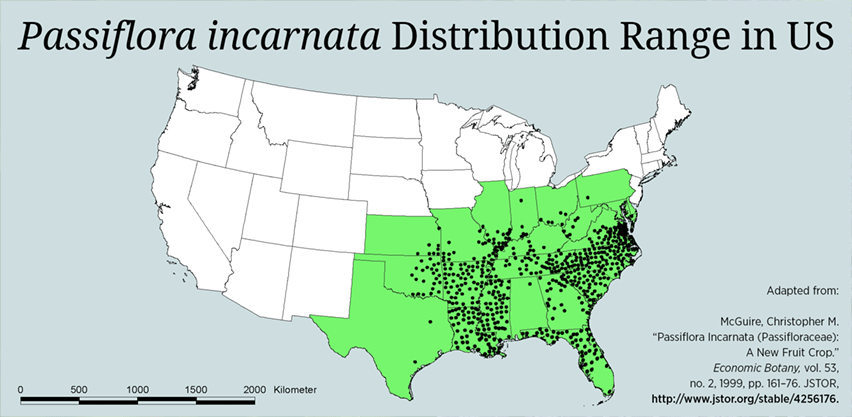
The maypop (Passiflora incarnata) has been found living in the wild in many states in the southeastern United States.
Yes, the Passiflora incarnata is a naturally occurring vine, so it's native to somewhere. Of course, that doesn't mean it's native to your area. Check the map above to see the reported native range in North America. Primarily, the Passiflora incarnata is known to grow in the southeastern United States. It has been found in states as north as Ohio and Pennsylvania.
As it turns out, humans have a long, rich history of consuming Passiflora incarnata fruits. Archaeologists have found the seeds on ancient human sites in the southeastern states. This indicates that Native Americans were consuming them as far back as the Late Archaic period. As time went on, the seeds become more abundant, which may indicate that humans were eating passionfruits more frequently. When European travelers arrived in the Americas, they noted various indigenous peoples would gather and consume the fruits. Many early settlers enjoyed eating the fruits as well.
Is the Maypop Passiflora incarnata an invasive plant?
It depends. In areas where the plant is known to be native, it cannot be classified as officially "invasive." According to the USDA only non-native plants can be considered as "invasives." Outside of its native range, you might find Passiflora incarnata on invasive plant lists. Regardless of the native status in any given area, the Passiflora incarnata is a VERY aggressively growing vine. And in that sense, it certainly has an invasive growth habit.
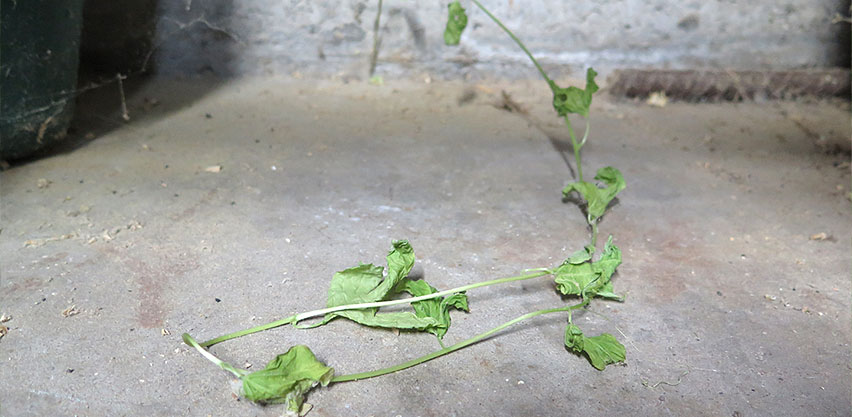
This maypop (Passiflora incarnata) traveled 13 feet under a concrete slab, sending up a sucker at a crack in the foundation!
It's not the seeds that make them so invasive. Rather, it's the extensive network of roots which can spread over a vast area. As the roots spread, they also send up shoots or "suckers" from the ground. Each sucker can grow into a long piece of vine. If you do not plan properly, you may find that the plant has taken over an entire bed. The unwanted vines will overtake other plants and block out sunlight. The passion fruit vine is a prime example of how "native" plants can actually grow more invasively than other "non-natives."
Even when Passiflora incarnata is not classified as an "invasive," it can still become a minor agricultural weed. It can compete with other plants for resources. So good planning is important before introducing this plant to your lot. Once the vine is established, it can be difficult to remove. Fortunately, there are ways to control its growth.
How to control the passionfruit plant?

The passionfruit vine has completely filled this fence a few years after planting.
It's possible for passiflora vines to spread by self-seeding. However, if you are diligent at gathering the fruit, this is a rather uncommon occurrence in the garden. The primary cause for concern relates to root spread and the resulting suckers. You'll need a method for controlling the plant by restricting its root spread. Even in colder climates, the Passiflora incarnata can become very difficult to manage after a period of several years. The plant can send roots 30 feet away from where it was first planted! Those roots can send up suckers all throughout your garden.
CONTAINER METHOD: If you need to keep a passionfruit's roots in check, you could try growing the vine in a container. This will work in extremely tight spaces such as small urban gardens. The technique has several disadvantages though. You need to select a very large pot, preferably 2 cubic feet in volume. The container should have a wide base to make sure the plant doesn't become top heavy, causing it to tip over in the wind. The pot needs drain holes, but these should not come in contact with the ground if the pot is resting on soil. Otherwise, you can expect the passion fruit roots to find their way out of those drain holes and then escape into the native soil.
If your maypop is grown in a pot, you'll need to water it much more frequently. Also, you'll lose a measure of cold-hardiness since the roots won't be protected within the sub-soil. In borderline zones such as zone 5 or 6 you might need to protect the pot during winter freezes so the roots don't die. You can try heeling in the pot, but you should watch that the roots don't escape containment. Or if you have an unheated garage, this could be a good spot to keep the dormant plant during the winter.
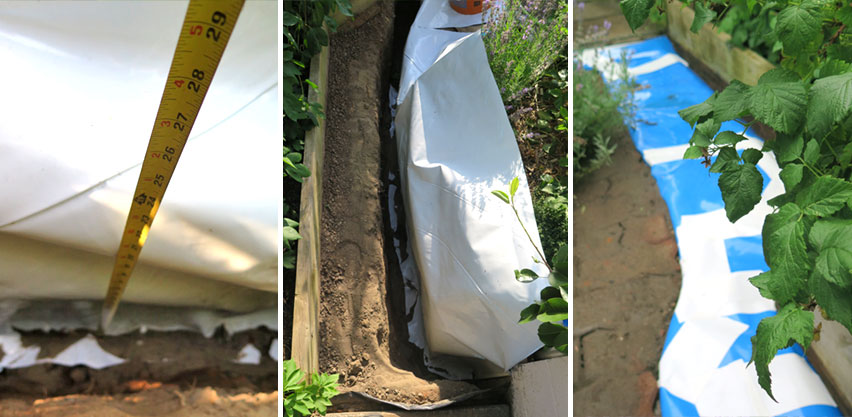
I dug a trench 24 inches deep & lined it with 20 mil plastic to create a rhizome barrier.
RHIZOME BARRIER: The best way to manage passionfruit vines is by creating a rhizome barrier. Dig a trench 18 to 24 inches deep. Line it with a continuous layer of thick plastic. I used heavy-duty 20 mil plastic. Make sure you tape any seams. This should create an impassable barrier to curtail the root growth. It is very effective at stopping the plants from spreading.
It's easiest if you plan and install your barrier at the time you first plant your passionfruits. However, you can retrofit a rhizome barrier as well. After placing the barrier, you might find suckers coming up outside of the barrier. They would be from remnant pieces of roots that remained in your soil. Dig them up if possible. At a minimum, you should keep ripping out any new suckers that emerge. Over time, the escaped root fragments should get starved out and they will die.
FAQs:
Are maypops passionfruits?
Yes! Some sources feel it necessary to create a disambiguation between "maypops" and "passionfruits." Although maypop refers exclusively to Passiflora incarnata, the term passionfruit has been used more broadly. Merriam-Webster defines passion fruit as "the edible fruit of a passionflower."
In particular, the tropical Passiflora edulis is often designated as "passionfruit" or "passion fruit." However the name "passionfruit" is not exclusive to Passiflora edulis. It has also been applied to P. caerulea, P. tarminiana, P. ligularis and P. quadrangularis. These are all in the same genus, namely Passiflora. Maypops are also passifloras.
People might be quick to refer to Passiflora incarnata as passionflower or passion vine, but they seem reluctant to call them "passionfruits." This distinction is not particularly useful. It does not properly differentiate one species from another. If a passiflora vine can be referred to as a "passionflower" then it could also be referred to as a type of "passionfruit." No doubt this was what Lee Reich had in mind when he wrote: "Maypop is a cold-hardy species of passionfruit..." (Reich, 2009, p. 132).
If you want to make a distinction between different passiflora species through the use of common names, then you need to include a descriptor. For example, the purple-fruited P. edulis f. edulis can be identified through the name "purple passionfruit." The yellow-fruited P. edulis f. flavicarpa is known as the "yellow passionfruit." Those can be distingushed from the P. caerulea which is commonly called the blue passionflower or "blue passionfruit" (Popay, 2022). Otherwise, if you use the term "passionfruit" by itself, then the more generic interpretation is implied. This merely references the entire genus, Passiflora. This interpretation is consistent with "The passionfruit growing guide" of Australian origin (Rigden, 2011, p. 3).
SOURCES:
McGuire, C.M. Passiflora incarnata (Passifloraceae): A new fruit crop. Econ Bot 53, 161–176 (1999). https://doi.org/10.1007/BF02866495
Reich, Lee A. Landscaping with Fruit: Strawberry ground covers, blueberry hedges, grape arbors, and 39 other luscious fruits to make your yard an edible paradise. (A Homeowners Guide). Storey Publishing, LLC, 2009.
Experts from Dole Food Company; Experts from The Mayo Clinic; Experts from UCLA Center for H (13 January 2002). Encyclopedia of Foods: A Guide to Healthy Nutrition. Elsevier. pp. 195. ISBN 978-0-08-053087-1.
Popay, I. (2022) 'Passiflora caerulea (blue passionflower)', CABI Compendium. CABI. doi: 10.1079/cabicompendium.116172.
Rigden, P. (2011) Passionfruit growing guide - Second edition. Manual. State of Queensland, Brisbane, Queensland.
Hardin, J. W., Doerksen, G., Herndon, D., Hobson, M., & Thomas, F. (1972). Pollination Ecology and Floral Biology of Four Weedy Genera in Southern Oklahoma. The Southwestern Naturalist, 16(3/4), 403–412. https://doi.org/10.2307/3670071

